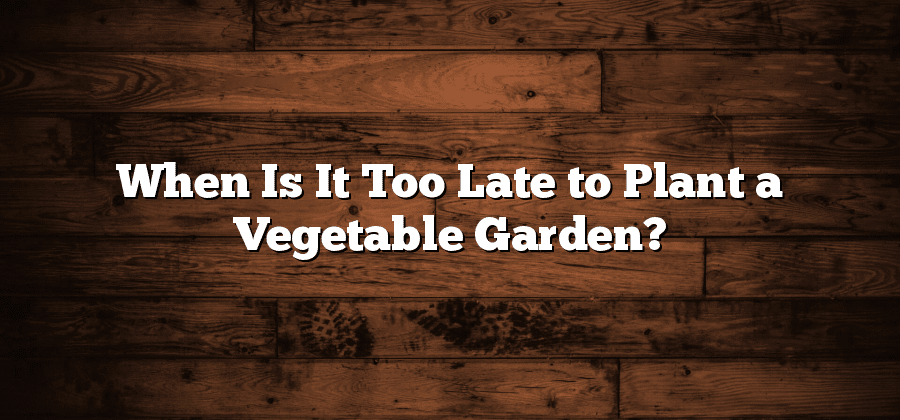Understanding the Optimal Planting Window
When it comes to gardening, understanding the optimal planting window is crucial for achieving success in growing healthy and productive vegetables. The optimal planting window refers to the ideal time frame for planting different vegetable crops, taking into consideration factors such as soil temperature, weather conditions, and the specific requirements of each crop. Proper timing ensures that the seeds or seedlings have the best conditions for germination and growth, ultimately leading to higher yields and a bountiful harvest.
The optimal planting window varies for different vegetable crops and is influenced by a range of factors. Some vegetables, such as tomatoes and peppers, require warm soil temperatures to thrive, while others, like cabbage and lettuce, tolerate cooler temperatures better. Additionally, the length of the growing season in your region and the specific local climate conditions will impact the timing of planting. By understanding these factors and assessing the needs of different vegetable crops, you can determine the most opportune time to sow seeds or transplant seedlings, giving them the best chance to flourish.
Factors Influencing Vegetable Planting Time
One of the primary factors influencing vegetable planting time is the specific requirements of each individual crop. Different vegetables have varying preferences for temperature, sunlight, and soil conditions. Some vegetables, such as tomatoes and peppers, require warm temperatures to thrive and should only be planted after the last frost date in your area. On the other hand, cool-season crops like lettuce and spinach prefer cooler temperatures and can tolerate light frosts, allowing for an earlier planting window.
Another factor that affects vegetable planting time is the length of the growing season in your region. If you live in a colder climate with a shorter summer, you may need to consider vegetables that have a shorter maturity time or opt for varieties that are more cold-tolerant. Conversely, if you have a longer growing season, you have more flexibility in choosing a wider range of vegetables to plant. Understanding these factors will help you make informed decisions about when to plant your vegetables for optimal success.
Assessing Your Local Climate and Frost Dates
It is crucial for gardeners to assess their local climate and understand the frost dates in their region when planning their vegetable planting schedule. The climate of an area plays a significant role in determining the success of a garden, and being aware of the average frost dates can help gardeners prevent damage to their plants.
To assess your local climate, start by gathering information from reliable sources such as the National Weather Service or local agricultural extension offices. Look for data on average temperatures, precipitation patterns, and length of growing seasons. Understanding these climatic factors will give you a clearer picture of what types of vegetables are most suitable for your area and when to plant them.
Determining the frost dates in your region is equally important. Frost can be a gardener’s worst nightmare, causing damage to tender plants and even killing them. By knowing the average last spring frost and first fall frost dates, you can plan your planting schedule accordingly. This information allows you to make informed decisions about when to start seeds indoors, when to transplant outdoor seedlings, and when to harvest your crops before the first frost.
Choosing the Right Vegetables for Late Planting
Late planting offers a unique opportunity to grow a variety of vegetables, despite the limited time available for growth. When selecting vegetables for late planting, it is crucial to choose those that have shorter growing seasons and are more tolerant of cooler temperatures. These vegetables should be able to thrive and produce a harvest before the first frost. Some great options to consider for late planting include spinach, lettuce, radishes, and green beans. These vegetables not only have relatively fast growth rates but also have the ability to withstand cooler temperatures, making them ideal choices for late planting.
Spinach is a versatile and nutritious vegetable that can be grown for both its tender leaves and baby spinach. It matures quickly, with some varieties ready to harvest in just 45 days. Lettuce, another leafy green, is another excellent choice for late planting. With an average maturity time of 50-60 days, lettuce can be harvested in abundance before the frost sets in. Radishes are a root vegetable that thrives in cool weather. They have a short maturation time of around 25-30 days, making them a perfect option for late planting. Lastly, green beans are a popular choice for late planting. These legumes can mature in as little as 50-60 days, providing a bountiful harvest of tender, crisp beans before the first frost arrives.
Tips for Extending the Growing Season
Warm weather and a longer growing season are essential for plants to thrive and produce a bountiful harvest. To extend the growing season and enjoy fresh vegetables even after summer ends, there are several tips you can follow. Firstly, consider using season extension tools such as row covers or cold frames. These can help protect plants from frost and provide the extra warmth they need to thrive. Additionally, be mindful of watering practices. As the weather cools down, plants may require less water, so adjust your watering schedule accordingly. Lastly, consider planting cold-tolerant vegetables and varieties that have a shorter growing time. These plants are more resilient to cooler temperatures and are more likely to mature before the first frost. By implementing these tips, you can prolong your growing season and enjoy homegrown produce well into the fall.






